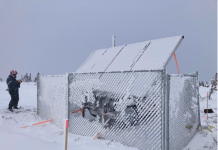In the avian world, the eagle is known as the apex predator, meaning no other bird considers an eagle its prey. The eagle is on the top of the avian food chain. But that doesn’t mean they live without dangers, most of which are man-made. There’s one man-made danger in particular that has led a Texas Tech University professor to work with several government agencies in an effort to discover ways to mitigate golden eagle deaths as much as possible.
With the push toward clean energy, West Texas and Eastern New Mexico have seen a tremendous growth in the popularity and construction of wind turbine farms. However, while they are essential to ending the United States’ dependency on fossil fuels, these wind farms have created a danger for the golden eagle in the same areas.
“Wind energy development throughout the western U.S. is ongoing and rampant, and it is an important renewable energy source,” said Dr. Clint Boal, a professor in the Department of Natural Resources Management in the College of Agricultural Sciences & Natural Resources and leader of this study. “But it doesn’t come without some ecological cost that can result in either displacement of wildlife or the direct mortality of wildlife. If the species is really abundant, it may not be a substantive issue, but when you have a species like the golden eagle that is not as abundant, has a long life span, and has low productivity, it does become an issue.”
 That’s why the research that Boal and his colleagues are performing is so important. Boal, a member of the United States Geological Survey’s Cooperative Research Unit at Texas Tech, along with the U.S. Fish and Wildlife Service’s Region 2 office and its Western Golden Eagle Team, are in the process of studying golden eagle movements and potential interactions with wind turbines by capturing golden eagle chicks before they can fly and affixing lightweight GPS transmitters on their backs. The chicks are returned to the nest, and their movements can then be tracked over the next several years.
That’s why the research that Boal and his colleagues are performing is so important. Boal, a member of the United States Geological Survey’s Cooperative Research Unit at Texas Tech, along with the U.S. Fish and Wildlife Service’s Region 2 office and its Western Golden Eagle Team, are in the process of studying golden eagle movements and potential interactions with wind turbines by capturing golden eagle chicks before they can fly and affixing lightweight GPS transmitters on their backs. The chicks are returned to the nest, and their movements can then be tracked over the next several years.
“Because these are alpha birds, their distribution is such that they have a large territory, and their primary cause of death that first year is starvation or accidents, just because they have to learn how to fly and hunt,” Boal said. “What happens when you start losing them through electrocution on power poles, flying into turbines, or getting hit by cars on the highway when they are scavenging carcasses is that it may have a population-level effect, and that is what the Fish and Wildlife Service is concerned about. Wind turbines are the most recent and potentially most dramatic of these.”
Protecting the Eagle
Golden eagles are not on the endangered or threatened species lists, but the species is protected under the Bald and Golden Eagle Protection Act. According to Boal, from the 1940s to the early 1960s, hundreds of golden eagles were killed, leading to them being added to the act in 1962. A golden eagle reaches full maturity in about five years and produces only one to two chicks per year, if any, when it reaches breeding age.
The golden eagle can be found throughout the western third of North America, from the western edge of the Great Plains to the Pacific Coast and from Alaska south to Mexico. A small population also is present in northeastern Canada.
However, according to Boal, there has been no real assessment of the golden eagle population in Texas since the 1970s. Boal did some studies in the Texas Panhandle in 2005 and 2006, but the growth of wind turbines presented a new danger.
Boal said that during the last two winters, he and other researchers have studied eagle habitats off the plains of Oklahoma and Texas and into Eastern New Mexico, examining both the birds that stay in the area year-round and those that migrate to the area every year. They’ve also examined some of the sites where golden eagles have nested since the 1970s, in the Trans Pecos region of Texas and, more closely, along the Caprock Escarpment.
Capturing a golden eagle is quite a process. Once an appropriate nest is located along the face of a cliff, a group of the researchers fan out across the bottom of the cliff. A climber descends from the top of the cliff above the nest and either captures it at the nest or it flees the climber by jumping from the nest. Though it can’t yet fly, the young eagle can glide very well — up to a kilometer, according to Boal — before reaching the ground.
There, the researchers capture the young eagle, put a hood over its head to keep it calm, affix the solar-powered GPS transmitter, tag the bird, and take blood samples for genetic analysis before the climber returns it to its nest.
Last year, Boal and the other researchers tagged and fitted six golden eagles in Eastern New Mexico, several of which migrated into the Texas Panhandle between Lubbock and Amarillo and into the Caprock. Another seven birds have been fitted and tagged this year so far.
“We’re able to track where they go to see if they interact with wind turbine farms, if they fly through to hunt in those areas, or if they avoid them altogether,” Boal said. “We hope to determine what the important features of the landscape they key in on, especially during that first year of life when they’re just learning how to be eagles and learning how to hunt.”
Protection Through Mitigation
Boal said that regardless of what the GPS trackers say about a golden eagle’s movements, not much can be done to change an eagle’s habits. So, the task for Boal and other researchers becomes ensuring that eagle habitats and the landscape are as conducive as possible to ensure survival and reproduction while, at the same time, having mitigation policies in place for landowners who erect wind turbine farms that could endanger eagles.
One mitigation strategy could be to put wind turbines in areas like a cotton field where the prey eagles hunt for is scarce. It’s the native grasslands where prey like jackrabbits and cottontail rabbits are most abundant, and eagles may venture to hunt even if there are wind turbines present.
Because golden eagles are protected, the Fish and Wildlife Service has developed an incidental take permit system. That program allows energy companies to apply for an incidental take permit that protects these companies from liability if an eagle is struck by a wind turbine blade, which would be a violation of the Bald and Golden Eagle Protection Act.
This is where some of the data that Boal and his team are collecting can be used to determine how many eagles are expected to be in an area and the potential for being killed if a wind energy center is placed in a certain area. But those incidental take permits usually span only about five to 10 years, and a condition of those permits is that for every eagle killed by a wind turbine, the energy company has to offset the loss by ensuring birth of a new eagle somewhere else or prevent an eagle in another location from dying from other causes.
The methods to ensure eagle productivity could range from putting money into a mitigation bank fund to be used in some management action to a direct action by the energy company itself.
Ensuring the viability of the landscape for eagles to hunt and capture prey is an area of particular interest for Boal. One example of that, he said, is the encroachment of juniper all along the Caprock. Juniper thickets not only reduce the number of jackrabbits and cottontails for eagles to capture, but it also makes it difficult to capture the ones that are there by allowing the rabbits to hide in the thickets.
Boal said landowners are interested in reducing juniper because it degrades the quality of land for cattle grazing and uses a large amount of water. Boal wants to find a way to estimate how many eagle chicks can be produced by restoring a certain amount of land to native grassland that eagles can hunt in.
“That’s a way where energy companies can say that they want to put money into a mitigation bank to help the landowners do what they already want to do and that is controlling the juniper and mesquite encroachment,” Boal said. “By doing that, the landowner wins because they receive financial assistance for improving the quality of range land for cattle. Eagles win because it provides a habitat for jackrabbits and cottontails, and it provides it in such a way that the landscape is more effective for foraging.”
In the long term, Boal said he would like to also study eagles’ food habits by putting remote cameras near eagle nests to see what kind of prey they bring back for their young. A better understanding of the diversity and proportions of different prey species used would help determine how to manage the landscape to ensure an adequate food supply for eagles to hunt.
“I think it’s a win-win for everybody involved,” Boal said. “You get clean energy through turbines and a good habitat for eagles, and it also benefits the cattle ranchers.”
Source: Texas Tech University
For more information, go to www.ttu.edu.



























